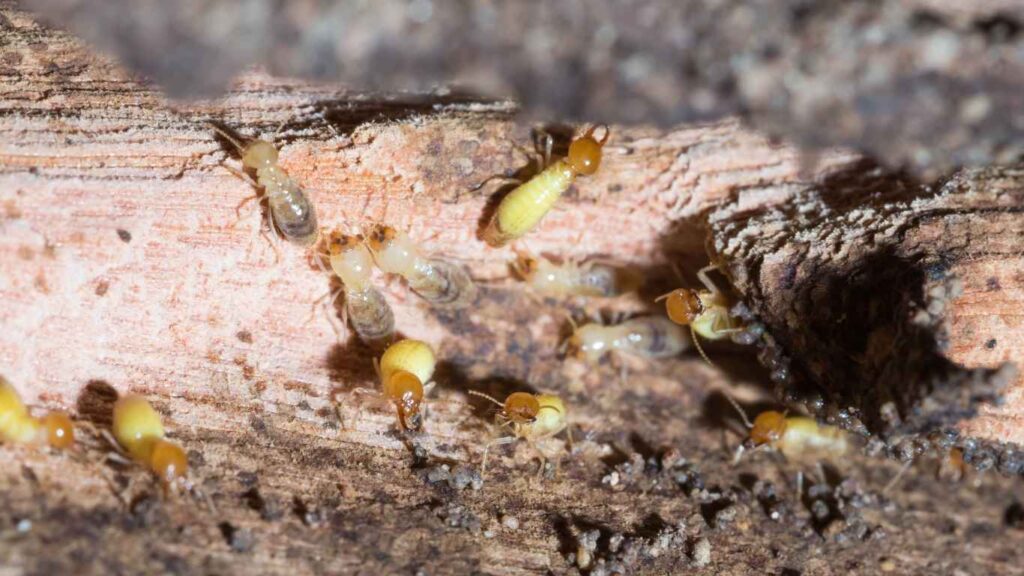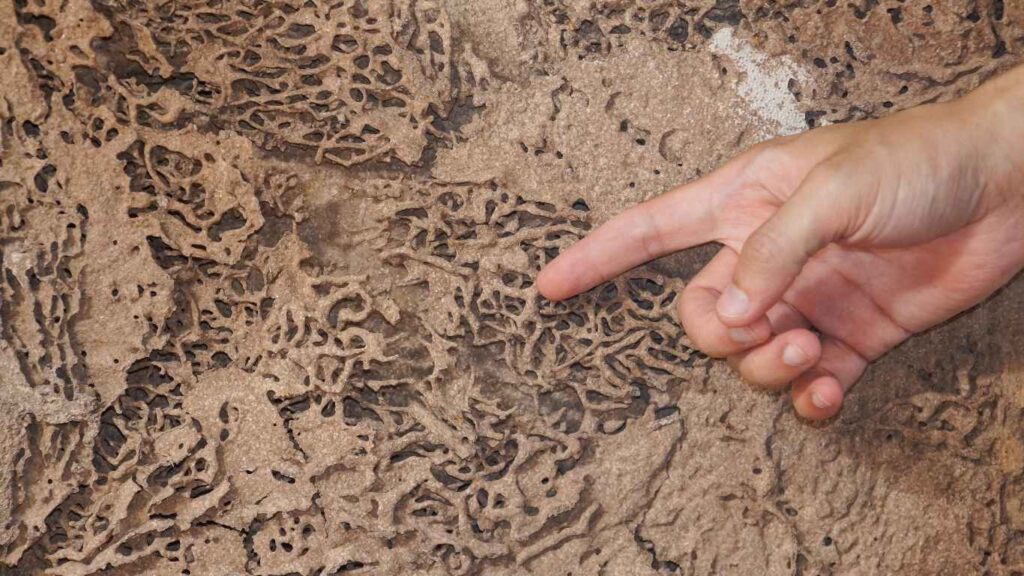Why Termites Are a Major Concern for Homeowners
Termites may be small, but they can cause massive damage to your home. These relatively silent destroyers can eat through the wooden structure of your house, costing you as a homeowner thousands of dollars in repairs. If left untreated, termites can weaken the literal foundation of your home, leading to structural instability and costly repairs.
“Termites cause more damage to homes every year than fires and floods combined—don’t wait until it’s too late.”
Don’t let termites silently destroy your home. Contact Official Pest Prevention today to schedule a free termite inspection and protect your biggest investment. Call us at (877) 711 2847
Recognizing, Preventing, and Solving a Termite Problem in Your Home
In this article, we’ve gathered the best tips from our termite experts to help you recognize, prevent, and solve termite problems before it’s too late. If you’re already dealing with an infestation and need immediate help, don’t wait—call us at (877) 711 2847 or fill out our contact form, and we’ll get back to you within 24 hours.
What are Termites?
Termites are small insects that live in colonies and feed on wood, decaying plants, cardboard, and other organic materials. They can cause serious damage to homes, making it essential for homeowners to understand what they are and how to identify them. While termites vary by species, they all share the same destructive potential. Knowing the type you’re dealing with is crucial for effective control.
Types of Termites & The Difference Between Termites and Carpenter Ants
Termites often look a lot like flying ants, but if you look closely, they have very distinct features. For instance, termites have thicker, segmented bodies without the narrow waistline characteristic of flying ants. Another distinction is that termites have two pairs of wings of equal length, while flying ants have shorter rear wings compared to their front wings. Need more help determining what insect you’re dealing with? Check out our article to learn more about the difference between Termites and Carpenter Ants.
Distinguishing Between Various Types of Termites
The various types of termites may look similar, but the way they live, what they eat, and how they interact with their environment sets them apart. Let’s break down the key differences between the major termite types.
Subterranean Termites:
The most widespread and damaging, these termites build hidden mud tunnels to access your home. Responsible for up to 95% of termite damage in the U.S., their colonies can contain up to a million termites. Identifying their presence early is essential for protecting your home. Subterranean termites are found throughout the United States and range in color from creamy white to dark brown or black, with lengths between ¼ and ½ inch.
Drywood Termites:
These termites thrive in drier environments and don’t require contact with soil. Commonly found in California, they can cause just as much damage, even though their colonies are smaller than subterranean termites. Their colonies tend to be smaller, with up to 2,500 members. Drywood termites are light brown in color and can grow between ⅜ and 1 inch in length.
Dampwood Termites:
As their name suggests, these termites live in wood with high moisture content. Though less common, they are particularly destructive in damp environments and can be found in areas like the Pacific Northwest. They typically live in smaller colonies and range in size from ½ to ⅝ inches. Dampwood termites are usually brownish-red in color.
Tell-tale Signs of a Termite Infestation
How can you be sure you’ve got a termite infestation? Spotting termites early is key to preventing damage. Here are some clear signs to look for:
- Mud tubes:
These pencil-sized tubes are built by termites as they travel from their nests to your home. - Discarded wings:
Termites shed their wings after swarming, and you may find them near windows or doors. - Damaged or Hollow Wood:
Wood that feels fragile or sounds hollow when tapped, is a sign termites may have been eating it from the inside. - Frass (Termite Droppings):
Small, pellet-shaped droppings resembling sawdust or ground pepper, often found near wooden structures. - Blisters in Wood Flooring:
Raised or discolored spots in wood flooring, indicating termites may have hollowed out the material underneath. - Swollen Floors and Ceilings:
Soft or bulging areas in floors or ceilings, caused by termites weakening the wood structure. - Head Banging Noises (Clicking or Tapping sounds):
You might be hearing faint clicking or tapping sounds, which termites produce when they bang their heads against wood as a form of communication. - Tight-Fitting Doors and Windows:
Warping or difficulty opening doors and windows, due to termites damaging the frames.
What Do Termite Droppings Look Like?
Termite droppings, or frass, are one of the earliest signs that termites may have invaded your home. These droppings look like small piles of tiny pellets, often resembling oval-shaped grains of sawdust or ground pepper. Frass is typically found near termite nests and is a strong indicator of drywood termites. Spotting these small pellets early can help you catch the problem before it causes serious damage.
Where Are Termites Usually Found?
Termites thrive in areas where they can feed, stay hydrated, and avoid disturbance. Inside your home, they gravitate toward moist, secluded spaces like basements, kitchens, and bathrooms. Outside, they often hide in woodpiles, old cardboard, or damp soil.
Subterranean termites build mud tunnels to move between their nests and food sources, while drywood termites prefer drier wooden structures. Dampwood termites, as the name implies, like to live in wood with a lot of moisture in it. Understanding where termites are likely to hide can help you catch an infestation early.
Proven Termite Control Solutions
What are the top most effective treatments for termite infestations? Dealing with termites requires swift action and professional solutions, like the following:
- Liquid treatments:
These are applied to the soil around your home to create a barrier that kills termites when they come into contact with it. - Baiting systems:
Bait stations are placed around the home to attract termites, which carry the bait back to their colony, effectively killing the entire colony. - Fumigation:
In severe cases, (professional) fumigation may be necessary to eliminate termites from your home.
How to get rid of Subterranean Termites
Subterranean termites can be tricky to eliminate, but termiticide treatments are the most effective solution. These treatments form a barrier around your home, preventing termites from accessing wood and spreading the chemical back to their colonies. Another – natural – method involves using beneficial nematodes—microscopic parasites that infect and kill termites in a natural, environmentally friendly way.
How to get rid of Drywood Termites
For drywood termites, you have a few options, from traditional termiticides to more natural alternatives like essential oils. Oils like orange and neem can be sprayed on affected areas, where they interfere with termites’ ability to molt and reproduce. Over time, these treatments reduce termite numbers and help protect your home.
How to get rid of Dampwood Termites
The best way to get rid of dampwood termites is to apply borate treatments to the affected wood. Borate kills the microorganisms in termites’ digestive systems, effectively starving the termites and eliminating the colony. While generally seen as safe for household use, be careful to use it on dry surfaces and as and avoid inhaling borate dust or direct skin exposure to concentrated forms.
As you may already see: treating wood with borate, when dealing with termites that thrive in damp wood, poses a problem if you can only apply the solution on dry wood. If you’re dealing with dampwood termites, fixing the moisture problem first is key. Then, once the wood is no longer wet, borate can be applied to protect it.
OPP’s Comprehensive Termite Solutions
At Official Pest Prevention, we offer tailored termite control services designed to eliminate infestations and prevent future damage:
- Thorough inspections:
Our experts will conduct a detailed inspection to determine the exact extent of the infestation and locate any colonies. - Custom treatment plans:
We use a tailored combination of liquid treatments and baiting systems to quickly and effectively eliminate termites and to protect your home long-term. - Ongoing monitoring:
Our advanced systems allow us to monitor termite activity and provide continued protection.
“We don’t just treat the symptoms of termite damage—we stop the problem at its source, and make sure it doesn’t come back later.”
Termite Prevention Tips
What you can do to protect your home from termites
Is there anything that you can do as a homeowner? Prevent termites from getting into your home with these practical tips:
- Reduce moisture:
Termites thrive in moist environments. Make sure you have proper drainage around your home and fix any leaky pipes or faucets. - Store wood away from the house:
Firewood and lumber should be kept at least 20 feet from your home to avoid attracting termites. - Regularly inspect all wooden structures:
Check decks, fences, and other wooden structures for signs of damage. Just a quick, attentive walkaround every couple of weeks can save you a lot of trouble.
What to Expect from OPP’s Termite Control Services
Have a termite problem that needs fixing right now? We understand you’re not just looking to fix a bug problem. You’re looking for peace of mind. What happens after you contact us, what are the steps? When you choose Official Pest Prevention, here’s what you can expect:
- Detailed inspection:
We thoroughly inspect your home to locate termite activity and assess the level of damage. - Tailored treatment:
We develop a plan to target the termites where they live, using the most effective treatments for your home. - Follow-Up & monitoring:
We provide ongoing support and monitoring to ensure your home stays termite-free.
Why Choose Official Pest Prevention?
Here’s what makes OPP the right choice for termite control in the state of California:
- Expertise in termite control:
With over 20 years of experience, we know exactly how to handle termite infestations and prevent further damage. - Local knowledge:
We understand the termite risks specific to Northern and Central California and tailor our solutions accordingly. - Satisfaction guaranteed:
We stand by our work with a satisfaction guarantee, ensuring you receive the best termite control service possible.
Protect Your Home from Termite Damage Today
Contact OPP now.
Don’t let termites silently destroy your home. Contact Official Pest Prevention today to schedule a free termite inspection and protect your biggest investment.
Termites can cause very costly damage if left untreated. Get your free inspection with Official Pest Prevention today and take the first step toward a termite-free home.

![How to Get Rid of Termites [Prevention & Control]](https://www.officialpestprevention.com/wp-content/uploads/2024/09/How-to-Get-Rid-of-Termites-Prevention-and-Control.jpg)




